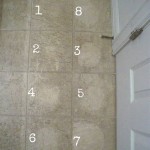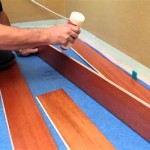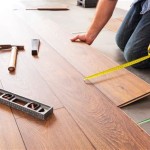How To Lay Vinyl Sheet Flooring In A Bathroom
Vinyl sheet flooring offers a practical and stylish solution for bathrooms. Its waterproof and durable nature makes it an ideal choice for this high-moisture environment. While the installation process may seem daunting, with proper preparation and careful execution, anyone can achieve a professional-looking result. This article will guide you through the steps involved in laying vinyl sheet flooring in your bathroom, from preparing the subfloor to finishing the installation.
1. Preparing the Subfloor
The success of your vinyl sheet flooring installation hinges on a solid and level subfloor. Before you begin, ensure the subfloor is free of any defects or moisture issues. If you have concrete subfloors, inspect for cracks or unevenness. If present, repair them with concrete patching compound. For wooden subfloors, check for squeaks, loose boards, or gaps. Secure loose boards and fill gaps with wood filler. To achieve a smooth surface, you can use a self-leveling compound.
Once the subfloor is level, it's crucial to ensure it's dry. Moisture can cause the vinyl sheet flooring to warp or buckle. To prevent this, allow the subfloor to dry completely after any repairs. Use a moisture meter to check for moisture levels. Ensure the subfloor is within the acceptable moisture content for vinyl flooring as per the manufacturer's instructions.
2. Installing the Underlayment
Underlayment provides a cushioning layer beneath the vinyl sheet flooring, enhancing comfort, sound insulation, and protecting the flooring from subfloor imperfections. It's important to select the appropriate underlayment for your bathroom. Moisture-resistant underlayment designed for bathrooms is recommended.
Before laying the underlayment, ensure the subfloor is clean and free from debris. Roll out the underlayment and cut it to size using a utility knife. The underlayment should overlap at the seams by at least 6 inches. Secure the underlayment using staples or adhesive tape, ensuring it is properly adhered to the subfloor.
3. Measuring and Cutting the Vinyl Sheet Flooring
With the subfloor and underlayment prepared, you can begin measuring and cutting the vinyl sheet flooring. Start by measuring the length and width of the bathroom, leaving an extra 6 inches on each side for trimming. This extra allowance for trimming accounts for any imperfections in the subfloor or walls.
Use a utility knife to cut the vinyl sheet flooring to size. A straightedge and a marker will help you make precise cuts. Ensure the cuts are straight and clean to avoid uneven edges. When cutting the vinyl sheet flooring, it's helpful to lay it out on a flat surface, such as a workbench, for easier and more accurate cutting.
4. Laying and Securing the Vinyl Sheet Flooring
Now, it's time to lay the vinyl sheet flooring. Start by placing the sheet flooring in the center of the room, ensuring it is aligned with the walls. Use a roller to smooth out any air bubbles trapped beneath the flooring. You can use a seam sealer or adhesive tape to create a seamless and watertight connection between the seams.
For smaller bathrooms, you can use a single sheet of vinyl flooring. For larger bathrooms, multiple sheets may be required. If you need to use multiple sheets, overlap them by at least 6 inches and use a seam sealer to create a watertight connection. If using adhesive, apply it to the subfloor and underlayment, ensuring it is evenly distributed before laying the vinyl sheet flooring.
5. Trimming and Finishing
Once the vinyl sheet flooring is laid, use a utility knife to trim the edges along the walls using a straightedge as a guide. Ensure the cuts are precise and smooth. It's best to use a sharp utility knife and a sturdy straightedge for clean and accurate cuts.
After trimming the edges, install baseboards or molding around the perimeter of the bathroom to cover the edges of the vinyl sheet flooring and create a neat finish. If you're installing baseboards, ensure they are properly secured to the walls. Secure the molding with nails or adhesive to create a smooth and polished look.
Finally, install transition strips at the doorways to create a seamless transition between the bathroom floor and the surrounding flooring. Transition strips help to prevent tripping and provide a smooth flow between different flooring types.
With a well-prepared subfloor, the right tools, and careful attention to detail, you can achieve a professional-looking installation of vinyl sheet flooring in your bathroom. Enjoy your new flooring.

How To Install Sheet Vinyl Floor Decor Adventures

How To Install Vinyl Plank Flooring In A Bathroom Fixthisbuildthat

How To Install Vinyl Sheet Flooring A Erfly House

How To Install Sheet Vinyl Floor Decor Adventures

How To Install Vinyl Sheet Flooring A Erfly House

How To Install Vinyl Sheet Flooring A Erfly House

How To Install Sheet Vinyl Flooring

How To Lay Vinyl Sheet In A Bathroom Flooring Factory

Diy How To Lay Vinyl Or Lino Flooring

How To Lay Sheet Vinyl Flooring
Related Posts








